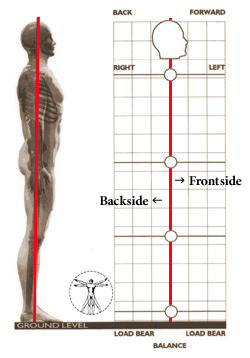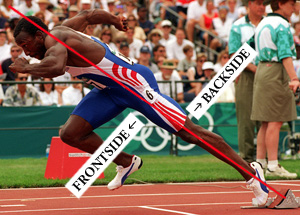[LEFT]  If you take the mid-line of your body in sagittal view, everything that happens in front both in air and on ground is Front Mechanics. Everything in back of mid-line on the ground and in the air is backside mechanics. The less time your leg spends in backside mechanics, the better your frontside mechanics will be. Ralph Mann writes that if you can reduce 10 degrees of backside upper leg travel, 10 degrees of front-side upper leg travel will occur…aka high knees, better frontside, etc. The main reason fast people let their leg move into backside mechanics is so there will be a stretch put on the hip-flexor that will immediately snap the upper leg back into front mechanics and create a better situation for applying force back into the ground. The slower the pace of the race, the less frontside will be needed to run race efficiently. Fast sprinting requires short ground contact times which require better front mechanics…slower pace running requires longer ground contact times which need less high knee front mechanics. All of this is related to pelvis stability, posture, correct oscillations, etc. which can get into a big presentation of information that I won’t get into here. For the 35K foot view of front mechanics, the less time spent in backside mechanics, the better opportunity to achieve good frontside mechanics. The more time spent in backside mechanics, the less opportunity to achieve good front mechanics. [/LEFT]
If you take the mid-line of your body in sagittal view, everything that happens in front both in air and on ground is Front Mechanics. Everything in back of mid-line on the ground and in the air is backside mechanics. The less time your leg spends in backside mechanics, the better your frontside mechanics will be. Ralph Mann writes that if you can reduce 10 degrees of backside upper leg travel, 10 degrees of front-side upper leg travel will occur…aka high knees, better frontside, etc. The main reason fast people let their leg move into backside mechanics is so there will be a stretch put on the hip-flexor that will immediately snap the upper leg back into front mechanics and create a better situation for applying force back into the ground. The slower the pace of the race, the less frontside will be needed to run race efficiently. Fast sprinting requires short ground contact times which require better front mechanics…slower pace running requires longer ground contact times which need less high knee front mechanics. All of this is related to pelvis stability, posture, correct oscillations, etc. which can get into a big presentation of information that I won’t get into here. For the 35K foot view of front mechanics, the less time spent in backside mechanics, the better opportunity to achieve good frontside mechanics. The more time spent in backside mechanics, the less opportunity to achieve good front mechanics. [/LEFT]
 Frontside and backside is related to mid-line, or long axis of the body. So when the long axis of body changes angles, front side and backside go with it. The time when most athletes wreck their front mechanics is when they are in drive phase and transitioning from drive phase to high speed running. If foot and leg get caught too long in backside mechanics during drive and transition, they will remain too much in backside mechanics when arriving in high speed running posture. I would include excessive knee flexion during first 10-12 steps of drive phase as getting too much backside. Disciplined front mechanics the first part(s) of the race will create a situation to remain in good front mechanics for sprinting later in a race. There is an old saying about racing, ‘once you lose your hips, you’ll never get them back’…and this is true for long races, short races, and field event runways. I’d suggest that you could substitute this saying, ‘once you get too deep into backside mechanics, you’ll never get a good front mechanics back’.
Frontside and backside is related to mid-line, or long axis of the body. So when the long axis of body changes angles, front side and backside go with it. The time when most athletes wreck their front mechanics is when they are in drive phase and transitioning from drive phase to high speed running. If foot and leg get caught too long in backside mechanics during drive and transition, they will remain too much in backside mechanics when arriving in high speed running posture. I would include excessive knee flexion during first 10-12 steps of drive phase as getting too much backside. Disciplined front mechanics the first part(s) of the race will create a situation to remain in good front mechanics for sprinting later in a race. There is an old saying about racing, ‘once you lose your hips, you’ll never get them back’…and this is true for long races, short races, and field event runways. I’d suggest that you could substitute this saying, ‘once you get too deep into backside mechanics, you’ll never get a good front mechanics back’.